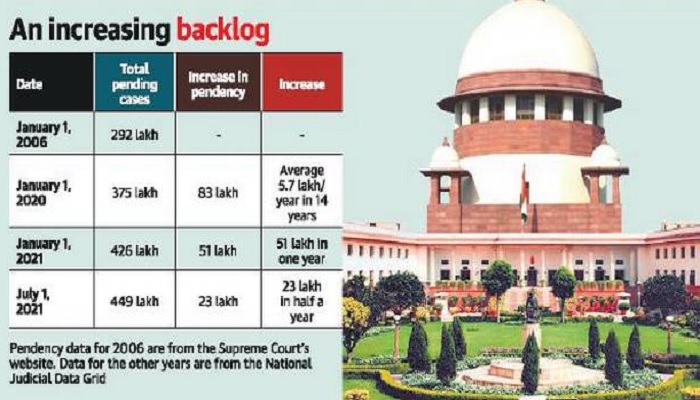(Mains GS 2 : Structure, organization and functioning of the Executive and the Judiciary)
Context:
- Recently, Chief Justice of India N.V. Ramana made a plea to ‘Indianise’ courts to make them responsive to the needs of the Indian citizens.
- Despite good intentions, the nation’s judiciary is hurtling due to the pendency of cases in courts across the country.
Pendency of cases:
- In the Indian justice system delaying is the biggest challenge as compared to other countries as 40% of cases are decided after three years in India, while in many other countries less than 1% of cases are decided after three years.
- The increase in corruption leads to inequality in justice as rich and powerful twisted cases expedited or delayed as they wish. The increase in corruption This severely impacts the justice delivery system for the poor and marginalised as the judicial process itself becomes a punishment for them.
- Data show that about 70% of prisoners in India are undertrials and are mostly poor citizens.

Filling judicial positions:
- To tackle erosion of trust in the judicial system it is necessary to fill the sanctioned judicial positions.
- Between 2006 and 2019, the average increase in pendency was less than 2% per year whereas the average vacancy in sanctioned judicial positions was about 21%.
- If the sanctioned positions had been filled, pendency of cases would have gone down each year.
Selecting the judges:
- The responsibility of selecting judges and their appointments largely depends on the judiciary itself.
- The appointment of subordinate judiciary lies with the State governments and their respective High Courts.
- The responsibility of ensuring near-zero vacancies should be with the Chief Justices of the High Courts and the Chief Justice of India.
Improve working:
- The use of technology is essential to ensure fast justice delivery.
- The e-Committee of the Supreme Court has made recommendations to use technology like computer algorithms to decide on case listing, case allocation and adjournments with only a 5% override given to judges.
- The e-Committee also made detailed SOPs on e-filing without lawyers or litigants having to travel to the courts or use paper.
Focus on virtual hearings:
- COVID-19 enhanced virtual hearing but physical hearing still predominates.
- If a hybrid virtual hearing model is adopted, the backlog of cases will come down.
- Thus it is required that the courts should switch to a hybrid virtual mode immediately and start disposing cases.
- This will make access to justice easier for litigants, reduce costs, and also give a fair opportunity to young lawyers from small towns.
Conclusion:
- India’s judicial system will certainly improve if measures like e-filing of petitions, algorithm-based computerised listings,hybrid virtual hearings, filling judicial vacancies etc can be implemented properly.
- These changes would make India the preferred nation for international investments and also fulfil the fundamental right to the speedy justice of citizens.


